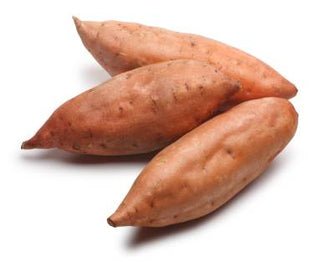(Ipomoea batatas)
Sweet potatoes are members of the morning glory family. The name is misleading because sweet potatoes are not related to potatoes. Sweet potatoes are engorged storage roots whereas potatoes are tubers or underground stems of a plant. When a potato has an “eye” or bud a new plant can be grown. Since sweet potatoes don’t produce eyes, the root will never grow a new plant.
Sweet potatoes have a similar shape to potatoes but are slimmer, with tapered ends. The smooth, thin skin of sweet potatoes can range in color from white, light yellow to red, purple or copper. The flesh inside also varies from light yellow to a deep, orange. Lighter colored sweet potatoes have a firm, dry flesh whereas the deep orange colored ones have a moist flesh.
Moist, soft sweet potatoes are often labeled yams but the two are not related. Yam, which comes from the West African word "nYami", meaning to eat, are grown primarily in Africa. Yams are much larger, starchier and drier than sweet potatoes.
When sweet potatoes were first cultivated only the drier variety was available. Later on the moist variety was grown and became more popular. The term yam was used to distinguish between the drier, lighter colored variety from the moist, deep orange variety. To avoid confusion, the USDA requires that products labeled as yams also include terminology that says sweet potato.
In the U.S., North Carolina produces almost 40% of the sweet potato crop. California, Louisiana and Mississippi are also big producers of this root vegetable.
Nutrition Facts
Compared to potatoes, sweet potatoes are lower in calories, carbohydrates and starch. A medium sized sweet potato has 103 calories, 24 grams of carbohydrates of which 4 grams are from fiber (15% of daily values), 7 grams from sugars and 8 grams from starches. In comparison, a medium potato has the same amount of fiber but 161 calories, 375 grams of carbohydrates with 29 grams from starches.
Sweet potatoes are an excellent source of beta-carotene, providing almost 22,000 IUs or 438% of daily values; vitamin C (17 mg or 28% DVs) and potassium (926 mg or 26% of DVs). Leaving the skin on during cooking increases the nutrient value of the food.
The intensity of the flesh color determines the antioxidant level of the vegetable. Deep, orange colored sweet potatoes have a higher antioxidant content. Regardless of color, antioxidants are concentrated in the skin of sweet potatoes. Like other purple colored vegetables, sweet potatoes with this colored flesh are an excellent source of anthocyanins.
Selection & Storage
The prime season for sweet potatoes is October through January but the root vegetable is available year-round in most supermarkets. Popular varieties include Goldrush, Georgia Red, Centennial, Puerto Rico, New Jersey and Velvet.
Sweet potatoes contain an enzyme that converts the starches into sugars as the root matures. This sweetness continues as the sweet potato is stored and cooked.
The appearance of sweet potatoes may not look smooth like a potato but that is fine provided the skin does not have wrinkles, bruises, sprouts or decay.
Unlike potatoes, a bad portion of a sweet potato can’t be cut out as the decayed spot creates an unpleasant flavor to the entire potato.
Sweet potatoes will last for about a month if stored in a dark, cool place. They should not be stored in the refrigerator as they can develop an off taste. If stored at room temperature, sweet potatoes will last about a week. Store potatoes loose and not in a plastic bag.
Do not wash sweet potatoes before storing as this will spoil them. Fortunately, sweet potatoes have few pests so pesticide use is low. However, prior to cooking, wash the skin of sweet potatoes with a vegetable brush.
Recipes
Sweet potatoes can be boiled, baked, grilled, steamed or even fried. Deep orange sweet potatoes cook more quickly than the yellow, firmer varieties.
While holiday recipes often call for adding considerable amounts of sugar and other caloric ingredients (e.g, marshmallow) to an otherwise healthy food, the simplest and most nutritious way to enjoy sweet potatoes is by baking them.
Thoroughly wash a sweet potato before cooking. Cut off the tapered ends. Cut sweet potato length wise and then cut each half in ¼ slices. Place in shallow pan and coat each slice with a little olive oil. Add pepper, salt and red pepper to taste. Bake at 350 degrees for about 35 to 40 minutes or until just turning soft.
Fun Facts
The town of Opelousas, Louisiana has celebrated “Yambilee” each October since 1946. After discovering natives eating sweet potatoes in the mid 1700s, this root vegetable has been a favorite food item ever since.
Sweet potatoes produce more pounds of food per acre than any other cultivated plant, including corn and Irish potatoes.

